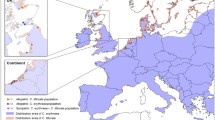Abstract
The purpose of this study is to examine floral trait variation between fourCyclamen species that show variation in their ability to reproduce in the absence of pollinators and in levels of inbreeding. Pollen and ovule production, pollen/ovule ratio, pollen volume, petal length and width, diameter of the corolla mouth, pistil and stamen length, and stigma-anther separation varied significantly between the four study species. Flower, pollen and ovule production, pollen volume and corolla size were generally highest inC. hederifolium, the species with the lowest level of inbreeding (mean Fis = 0.329), intermediate in both species with relatively high levels of pollinator-mediated inbreeding,C. repandum (mean Fis = 0.658) andC. creticum (mean Fis = 0.748), and lowest in the highly inbredC. balearicum (mean Fis = 0.930). The two species with the most different inbreeding coefficients,C. hederifolium andC. balearicum, had lower pollen-ovule ratios and shorter longevities of stigma receptivity and pollen viability thanC. creticum andC. repandum. These patterns of variation in floral traits are discussed in relation to the relatedness, pollination ecology and levels of inbreeding of the four species.
Similar content being viewed by others
References
Affre, L., 1996: Variation du système de reproduction et structuration génétique des populations chez quatre espèces du genreCyclamen (Primulaceae). — Unpubl. Ph.D. Thesis, Université des Sciences François Rabelais de Tours, France.
—,Thompson, J. D., 1997a: Variation in the population genetic structure of twoCyclamen species on the island of Corsica. — Heredity78: 205–214.
—, 1997b: Floral biology, mating system and population genetic structure of the Mediterranean island endemicCyclamen creticum Hildebr. (Primulaceae). — Biol. J. Linn. Soc.60: 527–549.
—,Debussche, M., 1995: The reproductive biology of the Mediterranean endemicCyclamen balearicum Willk. (Primulaceae). — Bot. J. Linn. Soc.118: 309–330.
—, 1997: The population genetic structure of continental and island populations of the Mediterranean endemicCyclamen balearicum Willk. (Primulaceae). — Amer. J. Bot.84: 437–451.
Anderberg, A. A., 1993: Phylogeny and subgeneric classification ofCyclamen L. (Primulaceae). — Kew Bull.49: 455–467.
Ashman, T.-L., Schoen, D. J., 1994: How long should flowers live? — Nature371: 788–791.
Bolos, O., De, Romo, A. M., 1991: Atlas corologic de la flora vascular dels països catalans.2. — Barcelona: Institut d'Estudis Catalans.
Buchmann, S. L., 1983: Buzz-pollination in angiosperms. — InJones, C. E., Little, R. J., (Eds): Handbook of experimental pollination biology, pp. 73–113. — New York: Van Nostrand Reinhold.
Charlesworth, D., Charlesworth, B., 1981: Allocation of resources to male and female functions in hermaphrodites. — Biol. J. Linn. Soc.15: 57–74.
—,Morgan, M. T., 1991: Allocation of resources to sex functions in flowering plants. — Philos. Trans.332: 91–102.
Charnov, E. L., 1982: The theory of sex allocation. — Princeton: Princeton University Press.
Cruden, R. W., 1977: Pollen-ovule ratios: a conservative indicator of breeding systems in flowering plants. — Evolution31: 32–46.
—,Lyon, D. L., 1985: Correlations among stigma depth, style length, and pollen grain size: do they reflect fuction or phylogeny. — Bot. Gaz.146: 143–149.
Debussche, M., Debussche, G., Affre, L., 1996: La distribution fragmentée deCyclamen balearicum Willk.: analyse historique et conséquence des activités humaines. — Acta Bot. Gallica142: 439–450.
Faegri, K., van der Pijl, L., 1979: The principles of pollination ecology. 3rd edn. — Oxford: Pergamon Press.
Grey-Wilson, C., 1988: The genusCyclamen. — Portland, Oregon.
Harder, L. D., 1990: Behavioral responses by bumble bees to variation in pollen availability. — Oecologia85: 41–47.
—,Thomson, J. D., 1989: Evolutionary options for maximizing pollen dispersal of animal-pollinated plants. — Amer. Naturalist133: 323–344.
—,Barclay, R. M. R., 1994: The functional significance of poricidal anthers and buzz-pollination: controlled pollen removal fromDodecatheon. — Funct. Ecol.8: 509–517.
Hildebrand, F., 1898: Die GattungCyclamen. — Jena.
Jain, S. K., 1976: The evolution of inbreeding in plants. — Annual Rev. Ecol. Syst.10: 173–200.
Knudsen, J. T., Olesen, J. M., 1993: Buzz-pollination and patterns in sexual traits in north EuropeanPyrolaceae. — Amer. J. Bot.80: 900–913.
Lloyd, D. G., 1988: Benefits and costs of biparental and uniparental reproduction in plants. — InMichod, R. E., Levin, B. R., (Eds): The evolution of sex, pp. 233–252. — Sunderland, Massachusetts: Sinauer.
Macior, L. W., 1964: An experimental study of the floral ecology ofDodecatheon meadia. — Amer. J. Bot.51: 96–108.
Mazer, S. J., Hultgaard, U. M., 1993: Variation and covariation among floral traits within and among four species of northern EuropeanPrimula (Primulaceae). — Amer. J. Bot.80: 474–485.
Mione, T., Anderson, G. J., 1979: Pollen-ovule ratios and breeding system evolution inSolanum sectionBasarthrum (Solanaceae). — Amer. J. Bot.79: 279–287.
Ramsey, M., 1993: Floral morphology, biology and sex allocation in disjunct populations of Christmas Bells (Blandfordia grandiflora, Liliaceae) with different breeding systems. — Austral. J. Bot.41: 749–762.
Rice, W. R., 1989: Analysing tables of statistical tests. — Evolution43: 223–225.
Ritland, C., Ritland, K., 1989: Variation of sex allocation among eight taxa of theMimulus guttatus species complex (Scrophulariaceae). — Amer. J. Bot.76: 1731–1739.
Sas, Institute Inc., 1990: SAS/STAT user's guide, vers. 6, 2. — Cary, North Carolina.
Scheiner, S. M., 1993: MANOVA: multiple response variables and multispecies interactions. — InScheiner, S. M., Gurevitch, J., (Eds): Design and analysis of ecological experiments, pp. 94–112. — London: Chapman & Hall.
Schoen, D. J., 1982a: Male reproductive effort and breeding system in an hermaphroditic plant. — Oecologia53: 255–257.
—, 1982b: The breeding system ofGilia achilleifolia: variation in floral characteristics and outcrossing rate. — Evolution36: 352–360.
Sokal, R. R., Rohlf, F. J., 1981: Biometry. 2nd edn. — New York: Freeman.
Webb, C. J., Lloyd, D. G., 1986: The avoidance of interference between the presentation of pollen and stigmas in angiosperms. II. Herkogamy — New Zealand J. Bot.24: 163–178.
Wyatt, R., 1983: Pollinator-plant interactions and the evolution of breeding systems. — InReal, L., (Ed.): Pollination biology, pp. 51–95. — London: Academic Press.
Author information
Authors and Affiliations
Rights and permissions
About this article
Cite this article
Affre, L., Thompson, J.D. Floral trait variation in fourCyclamen (Primulaceae) species. Pl Syst Evol 212, 279–293 (1998). https://doi.org/10.1007/BF01089743
Received:
Revised:
Accepted:
Issue Date:
DOI: https://doi.org/10.1007/BF01089743




